Chest dips are an effective exercise to target your pectorals, triceps, and delts. But to gain the greatest benefits, you should be lifitng a suitable weight. This post shares weight standards for dips.
The average beginner should be able to do a single dip with approximately 10% of their body weight in assistance. Intermediates and advanced lifters should be able to do a single weighted pull-up with around 55% and 85% of their body weight added, respectively.
The weight standards in this post will help you determine what is a respectable weight to be lifting based on your gender, body weight, and training experience.
I’ll also share 5 common reasons for a below-average dip.
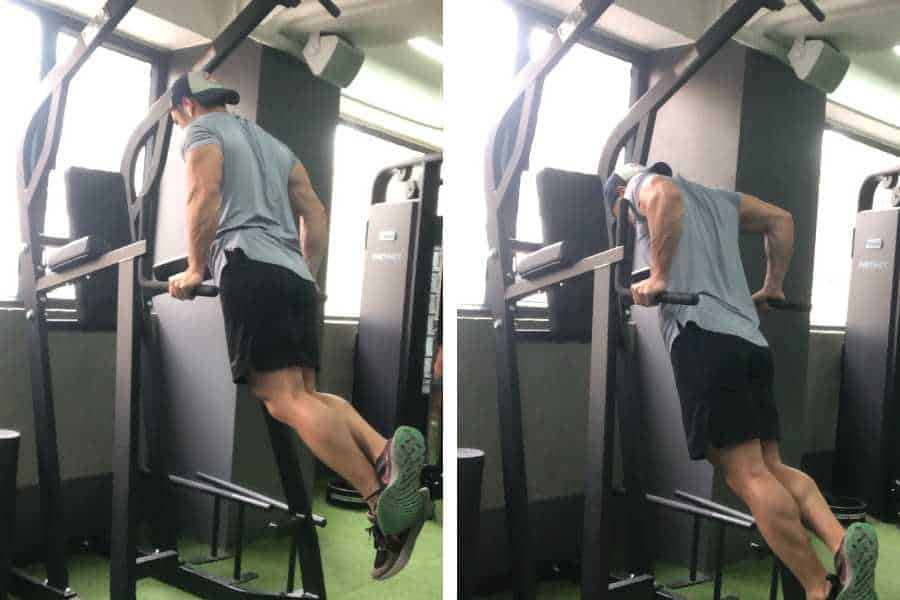
Types Of Dips
For the purpose of definition, this post focuses on the chest dip rather than the tricep dip.
These are the types of chest dips covered by my weight standards:
- Weighted (weight attached).
- Unassisted (using bodyweight-only)
- Assisted (assistance from a machine or bands).
This is a more accurate way to give chest dip standards since most beginners cannot do a traditional bodyweight dip without assistance.
Weighted dips use external weights (e.g. a dumbbell held between the legs or a weight plate attached by a chained belt) to add resistance and make it harder to perform.
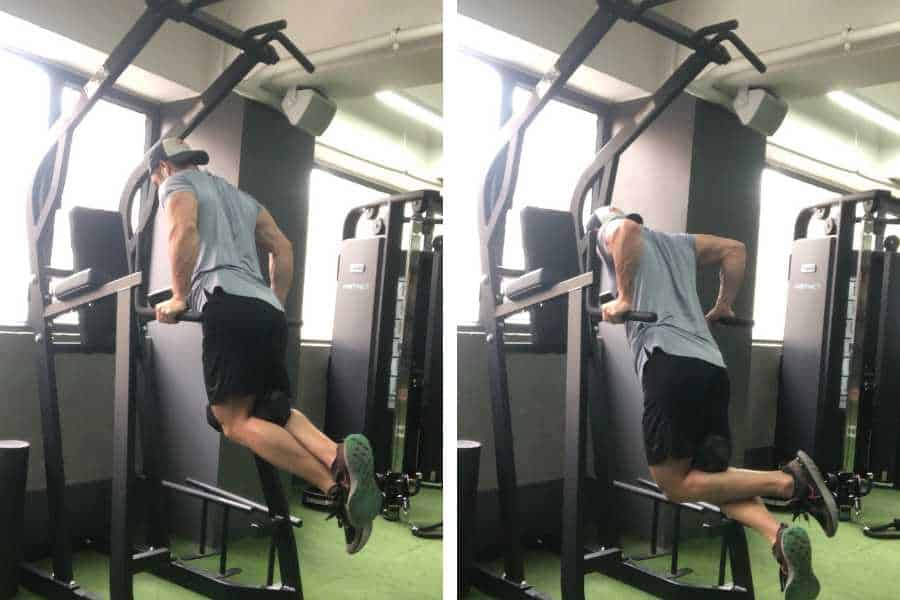
Assisted dips use external equipment (e.g. resistance bands) to decrease resistance and the exercise easier to perform.
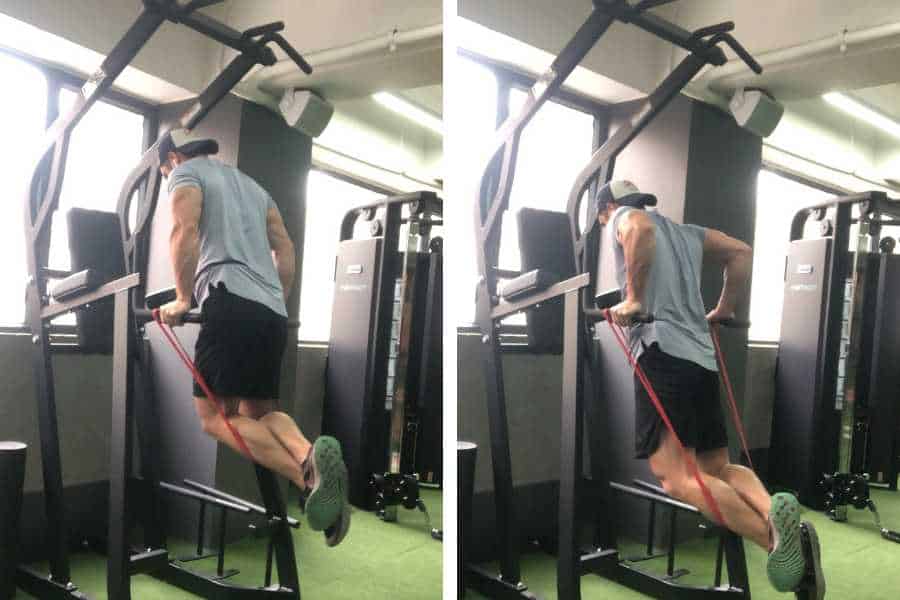
How To Use These Dips Weight Standards
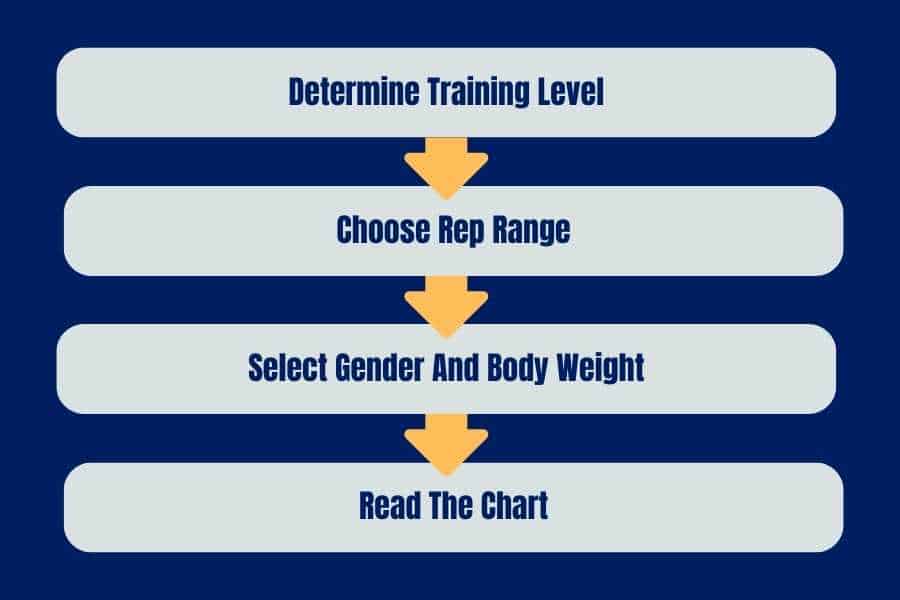
1) Determining your training level:
- Beginners have practiced the dip for 1-12 months.
- Intermediates have practiced the dip for 12-36 months.
- Advanced lifters have practiced the dip for 4 years or more.
2) Choosing your rep range:
The weight standards are given for:
- 1-rep max (1RM)- this is the maximum amount of weight you can lift for a single repetition. It’s often used as a strength standard.
- 6-10 working reps- this is generally considered to be the ideal rep range for building muscle.
3) Selecting your gender and body weight:
- Average dips standards are revealed for common body weights.
- Weighted dips standards are given for males.
- Females can use a 60% conversion (multiply the weight standard by 0.60).
4) Reading the charts:
- Dips standards are given as lbs on the top and kg on the bottom.
- + indicates extra weight added to your body weight (i.e. weighted dip).
- – indicates weight reduced from your body weight (i.e. assisted dips).
- If you’re doing dips at or above the weight standard for your given training level, body weight, and gender, then you are lifting a respectable amount of weight.
Beginner Dips Weight Standards
Here’s how much weight you should be lifting on the dip as a beginner:
| Bodyweight | 1-rep max | 6-rep max | 7-rep max | 8-rep max | 9-rep max | 10-rep max |
|---|---|---|---|---|---|---|
| 120lb 54kg | -17lb -8kg | -31lb -14kg | -35lb -16kg | -38lb -17kg | -40lb -18kg | -41lb -19kg |
| 150lb 68kg | -9lb -4kg | -17lb -8kg | -21lb -10kg | -24lb -11kg | -26lb -12kg | -27lb -12kg |
| 200lb 91kg | +0lb +0kg | -15lb -7kg | -18b -8kg | -20lb -9kg | -21lb -10kg | -22lb -10kg |
| 250lb 113kg | +3lb +1kg | -11lb -5kg | -14lb -6kg | +16lb -7kg | -17lb -8kg | +17lb +8kg |
| 300lb 136kg | +0lb +0kg | -15lb -7kg | -18lb -8kg | -20lb -9kg | -21lb -10kg | -22lb -10kg |
Generally speaking, beginners should be able to do an assisted dip with 1 to 15% of their body weight in assistance, for a single rep (1-rep max).
Intermediate Dips Weight Standards
Here’s how much weight you should be lifting on the dip as an intermediate lifter:
| Bodyweight | 1-rep max | 6-rep max | 7-rep max | 8-rep max | 9-rep max | 10-rep max |
|---|---|---|---|---|---|---|
| 120lb 54kg | +73lb +33kg | +61lb +28kg | +60lb +27kg | +58lb +26kg | +57lb +26kg | +53lb +24kg |
| 150lb 68kg | +95lb +43kg | +80lb +36kg | +78lb +35kg | +76lb +34kg | +74lb +34kg | +69lb +31kg |
| 200lb 91kg | +121lb +55kg | +102lb +46kg | +99lb +45kg | +97lb +44kg | +94lb +43kg | +88lb +40kg |
| 250lb 113kg | +136lb +62kg | +114lb +52kg | +112lb +51kg | +109lb +49kg | +106lb +48kg | +99lb +45kg |
| 300lb 136kg | +145lb +66kg | +122lb +55kg | +119lb +54kg | +116lb +53kg | +113lb +51kg | +106lb +48kg |
Generally speaking, intermediates should be able to do dips with an extra 50-60% of their body weight added, for a single rep (1-rep max).
Advanced Dips Weight Standards
Here’s how much weight you should be lifting on the dip as an advanced lifter:
| Bodyweight | 1-rep max | 6-rep max | 7-rep max | 8-rep max | 9-rep max | 10-rep max |
|---|---|---|---|---|---|---|
| 120lb 54kg | +130lb +59kg | +109lb +50kg | +107lb +48kg | +104lb +47kg | +101lb +46kg | +95lb +43kg |
| 150lb 68kg | +159lb +72kg | +134lb +61kg | +130lb +59kg | +127lb +58kg | +124lb +56kg | +116lb +53kg |
| 200lb 91kg | +193lb +88kg | +162lb +74kg | +158lb +72kg | +154lb +70kg | +151lb +68kg | +141lb +64kg |
| 250lb 113kg | +216lb +98kg | +181lb +82kg | +177lb +80kg | +173lb +78kg | +168lb +76kg | +158lb +72kg |
| 300lb 136kg | +229lb +104kg | +192lb +87kg | +188lb +85kg | +183lb +83kg | +179lb +81kg | +167lb +76kg |
Generally speaking, advanced lifters should be able to do dips with an extra 75-100% of their body weight added, for a single rep (1-rep max).
How Good Is Your Dips Weight Standard Vs Others?
Here’s the average percentage of people who can do a dip with varying degrees of assistance and added weight:
| Dips 1RM (As A Fraction Of Body Weight) | % Of People Who Can Do It |
|---|---|
| 0.50x | 100% |
| 0.60x | 100% |
| 0.70x | 100% |
| 0.80x | 99% |
| 0.90x | 97% |
| 1.00x | 95% |
| 1.10x | 91% |
| 1.20x | 85% |
| 1.30x | 78% |
| 1.40x | 70% |
| 1.50x | 60% |
| 1.60x | 50% |
| 1.70x | 41% |
| 1.80x | 32% |
| 1.90x | 24% |
| 2.00x | 18% |
| 2.10x | 13% |
| 2.20x | 9% |
| 2.30x | 6% |
| 2.40x | 4% |
| 2.50x | 3% |
The above table allows you to compare your dip standard with others.
To calculate your dip as a fraction of your own body weight, simply divide the weight of your 1RM by your body weight.
For example:
If you can do an unassisted dip (no extra weight or assistance) for 1 rep, then you’re lifting 1.00x your body weight.
And if you weigh 150lbs and you can do a weighted dip with a 15lb dumbbell held between your legs for 1 rep, then you’re lifting 1.10x your body weight.
Anything less than 1.00x your body weight is an assisted dip.
The above chart indicates:
- 75% of people can dip 1.35x their body weight for 1 rep. This represents the lower quartile of lifters and is a respectable weight for beginners to achieve.
- 50% of people can dip 1.60x their body weight for 1 rep. This represents the median quartile of lifters and is a respectable weight for intermediates to achieve. It’s also a realistic target for beginners to aim towards with enough training.
- 25% of people can dip 1.90x their body weight for 1 rep. This represents the upper quartile of lifters and is a respectable weight for advanced lifters. It’s also a realistic target for intermediates to aim towards with enough training.
Reasons & Solutions For A Below-Average Dip Standard
According to a poll I conducted, the pectorals (the main target muscle in the chest dip) are one of the most difficult muscles to grow. This can make the dip hard to execute.
Here are 5 common reasons why you may find the dip difficult and why your weight standards are below average.
I’ve also shared solutions for each problem. These solutions can help to improve your dipping strength.
1) Inadequate upper body strength
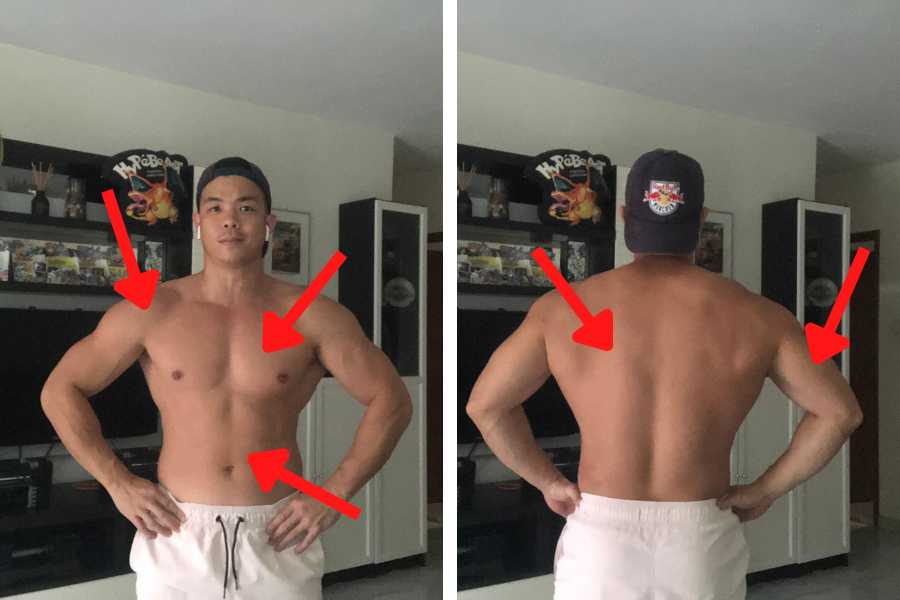
The chest dip is a compound exercise that mainly targets the lower-mid chest. But the shoulders and triceps also play a significant role in helping you generate power.
Furthermore, all of the neighboring muscles in the upper body are also recruited to some degree for stabilization.
Therefore, the dip is a complex exercise that requires a strong upper body to exercise effectively. You’ll likely find it difficult if you are new to strength training and have not yet developed the target muscles.
Solution:
Be patient. Keep practicing and remember to apply the form cues detailed next. Correct lifting form is essential for generating maximum strength in the chest dip (it’s a relatively technical exercise).
Additionally, it’s ok to start with assisted dips first. These are great for beginners to practice lifting form as well as building upper body strength.
But make sure you progressive overload by reducing the assistance in small increments over time.
Finally, performing other exercises to build your arms and shoulders will also contribute to a stronger chest dip.
2) Vertical torso
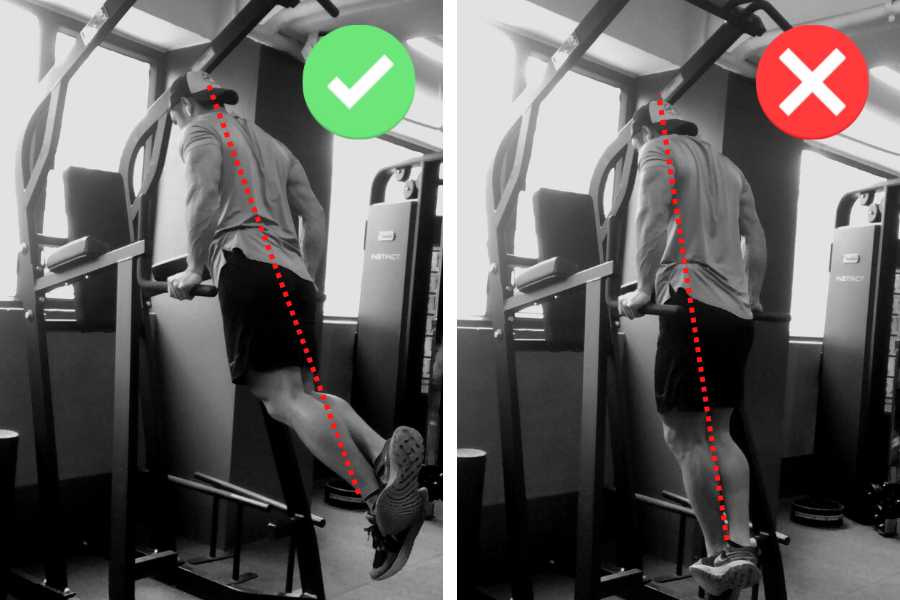
Remember- the chest dip is predominantly a chest exercise.
A common beginner form mistake is to perform the dip with a vertical torso. This shifts tension away from the pectorals (a large muscle) and onto the triceps (a small muscle).
Consequently, pressing strength is reduced.
Torso angle, therefore, plays a significant role in how much strength you can generate. And a torso that is too vertical will shift emphasis away from the pecs to the triceps, making the dip much harder to execute.
Solution:
It can be helpful to think of this exercise as a suspended incline push-up (or decline bench press).
In order to ensure tension is placed on the chest, and not the triceps, you need to angle your torso forwards.
This means your chest should be pushed out and slanted toward the floor. As a result, you’ll be working the pectorals rather than the triceps alone.
And as you know, a stronger chest results in a stronger dip!
You may also be interested in my other post for dumbbell exercises (no bench required) that can complement the dip to build a stronger chest.
3) Weak core strength
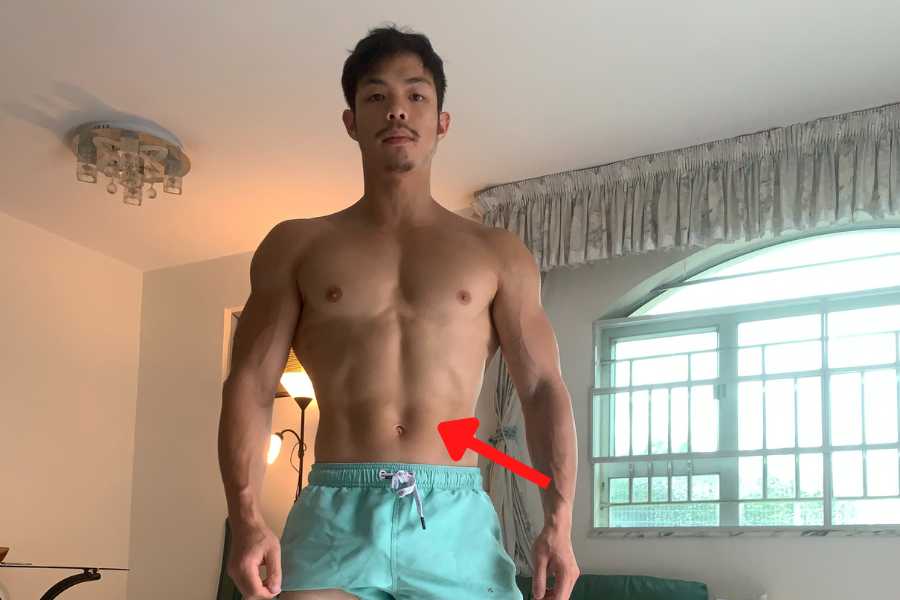
Whilst the dip primarily engages the chest, arms, and shoulders, it also requires a degree of core strength.
A strong core is needed to stabilize your torso and maintain the forward-lean posture described in the previous section.
As such, having weak core strength can make it difficult to execute the dip with good form.
Therefore, you may find it that your dip strength is below average if you have a weak core.
Solution:
Start your dips program using a lightweight first. Don’t be afraid to use band assistance if you’re a complete newbie or if you’re struggling to complete more than 5 reps of unassisted dips.
However, make sure you increase the intensity by reducing the assistance. This is called progressive overloading (you can check out my article to find out how to determine the ideal weight to lift).
Your core strength will naturally improve as you apply progressive overload over time, and this should coincide with a stronger dip.
As a skinny beginner, it’s also highly recommended to train your core with a variety of ab exercises.
This is not to just give you a six-pack physique (which is a bonus), but also to help you perform better on compound lifts such as the chest dip.
4) Internally rotated shoulders
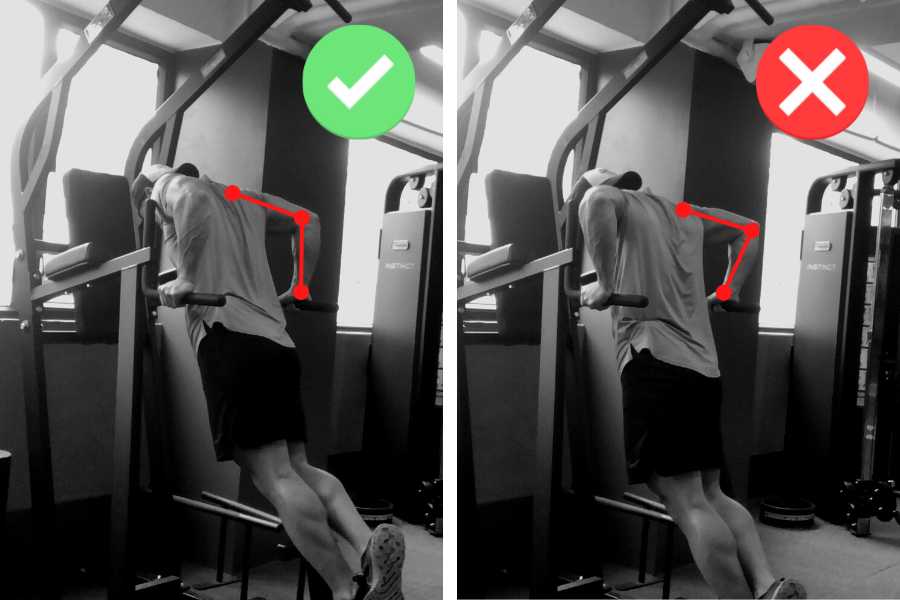
When performed incorrectly, the chest dip can place a lot of stress on your shoulders. This can make the exercise difficult and even painful to perform.
Internal rotation is one of the most common reasons for shoulder discomfort in this exercise.
This describes your shoulders rotating in and downwards. You can feel this for yourself by holding out your left arm and twisting it clockwise. It doesn’t take much for it to start becoming uncomfortable!
Internally rotating your shoulders can significantly reduce the amount of weight you’re able to lift on the dip and may explain why your chest isn’t getting stronger.
Solution:
The best way to avoid internal shoulder rotation is to tuck your elbows toward your torso as you go through the exercise.
Additionally, it helps to stack your elbows above your wrists. Avoid flaring your elbows outwards.
5) Not having a realistic progression plan
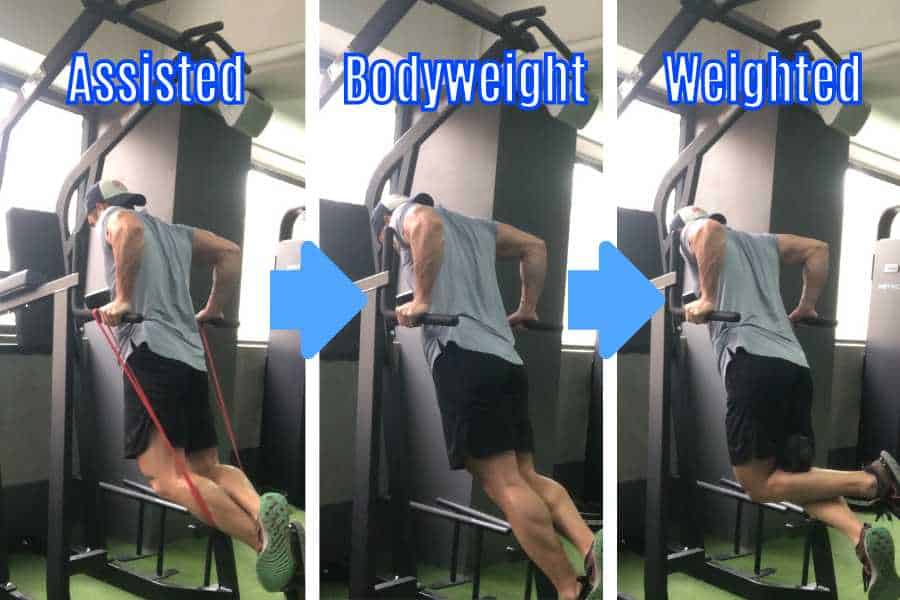
Let’s be honest here- dips are a challenging exercise that many people struggle with.
Not following a progression plan is a common reason why beginners (and even intermediate lifters who’ve never performed this exercise before) find it difficult to progress with the chest dip.
It’s always a good idea to lift heavy to build muscle. But the weight should also be light enough for you to perform 6-12 reps with good form.
This ensures your muscles are getting a sufficient training volume to grow and become stronger.
Solution:
If you’re lifting below average or if you’re struggling with this exercise, then it’s a good idea to go back to basics.
Be patient and start with a lightweight. Progressive progressive overload using small but regular weight increments (refer to the image above for an example dips progression plan).
It’s also a good idea to do a variety of exercises to work the whole body, alongside your dips.
Building full-body strength is one of the best ways to get stronger on the dip (beginners may be interested in my 3-day home workout routine).
Other Weight Standards For Dip Muscles
The dip primarily engages the pectorals, triceps, and deltoids. Here are the weight standards of other exercises that also work similar muscle groups.
- Dumbbell bench press– compound horizontal pressing exercise that works the same muscle groups as the dip but with a greater emphasis on the mid and upper pectorals.
- Dumbbell fly– isolation-type exercise that focuses on the pectorals.
- Tricep extension- isolation-type exercise that focuses on the triceps.
- Shoulder press– compound vertical pressing exercise that shifts a greater emphasis onto the deltoids.
- Lateral raise– isolation-type exercise that focuses on the lateral deltoids.
- Dumbbell tricep extension– isolation-type exercise that focuses on the triceps.
You may also be interested in my other post for a list of interesting bench press world records!
Conclusion
I’ve shared weight standards for chest dips, based on my personal 5-years of experience in weight training.
Beginners should be able to do 1 dip rep with around 10% of their body weight in assistance.
Intermediates should be able to do dips with approximately 55% of their body weight in added resistance, and advanced lifters approximately 85%.
If you’re lifting at or exceeding these strength standards, then you’re doing a good and respectable job.
I’ve also shared common problems and solutions if your dip strength is below average.
You may also be interested in the downloadable Kalibre Blueprint PDF which details exactly how I gained 40lbs of lean muscle (it’s 100% free!). It details the exact exercises and nutrition (with printables) I used to go from skinny to ripped!


